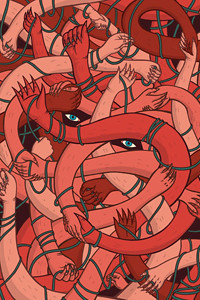
Comics: Rehabilitating Mr. Wiggles
Website: neilswaab.com (warning: Neil's comics are hilarious but possibly the most offensive comics being syndicated today. Not recommended if you're easily offended. -MK)
Making comics since year of: 1994 (professionally since 2000)
Art education/schools attended: Syracuse University, BFA in Illustration
Tools
Pencils: Mechanical pencils with .5 HB lead. I don't usually draw at very large sizes so I can get more detail in with sharp, thin leads. I also don't like to waste time sharpening.
Inks: Rarely use. If so, black india ink (no loyalty to any brand).
Brushes: Faber-Castell PITT Brush pens. These things are great. No dipping necessary. Great, sharp black. Nice tip and variation of line. I find that I need to get a new one every couple of illustrations or big comic pages though because the tip tends to get a little screwed up where I can't get the thin, sharp lines from it that I could when it was brand new.
Pens: Micron pens, Staedtler pigment liners, Zig writers. No dipping necessary and they're nice and sharp black. I can also get some line variation out of them by pressing really hardly or really lightly and flicking them off the page quickly.
Paper: Strathmore Bristol plate with smooth finish (300 series). Also xeroxes and prinouts on regular printer/xerox paper. This is just what I've found has worked the best for me, is cheapest, and also light enough to put on a light table in case I have to trace anything.
Lettering: Micron pen and sometimes Zig writer for all the same reasons above. Also, I made a font of my handwriting and sometimes on occasion I will use that if I'm in a huge rush and can't hand-letter or if I'm working digitally.
Color: Photoshop. Photoshop kicks ass and I've got a system down with how I color that lets me work quickly, make changes easily, and screw around with color a lot until I feel it's right. Working digitally also lets me work right up to the deadline because then I can just email over the file instead of having to worry about Fed Ex.
Layout/ Composition: Usually just in my head since I do strips and not full comics. If I need to sketch something out, usually in the margins of my typed manuscript for the comic. I don't usually sketch out a comic for more than a couple minutes anyway so whatever I do it on is no big deal.
Convention Sketches (when different from illustrations done in the studio): Usually just pencil.
Tool timeline, starting from when you began drawing in any serious way until the present, and what spurred the changes: Pencils have always been mechanical .5 because I like them. Inks have been everything from crow quills to brushes to what I use now. I interned for an animation studio for a summer in college and was influenced by their use of not varying line quality and got into using Micron pens from that. Now, I mix it up a little more as I miss the variation of line.
What tools you'd never use, and why: Anything with acid because it will eat away your paper and turn your art yellow!
And lastly, any advice you'd like to give: It's not the tools, but the thought behind you art. You can make great art with a stick, mud, and paper. Learn to make good, meaningful art first and then the tools will just help to refine and polish your image.
Neil's giving a reading at The Strand bookstore in NYC on Monday, November 13th from 7-8:30 pm. It's the Smyles and Fish Pocket Edition Launch Party with Jonathan Ames, Arthur Nersesian, Mike Topp, and the Smyles and Fish gang. Reception afterward at VON (3 Bleeker St.) 9-Whenever.

No comments:
Post a Comment